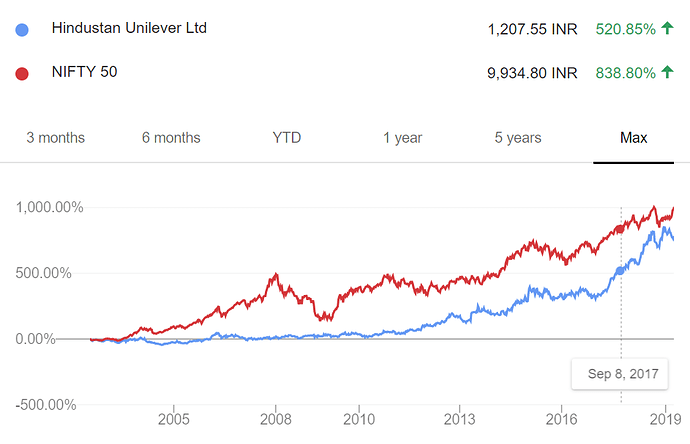No stock in any portfolio for a Permanent Buy and Hold portfolio will continue growing.
Imagine going to an All You Can Eat Restaurant in the USA or at BBQ Nation in India. That is the “growth” phase of a stock like Reliance or HUL or any of the Tata’s. Then comes the ‘digestion’ phase, where it is not doing anything but just resting like a Bear or Bull that has eaten a lot and move side-ways, downwards or up and down. This ‘digestion’ phase is a test for long term investors. We just have to be patient.
HUL is a perfect poster child. It traded between 190 to 281. Boring. No performance. Over-valued. I even sold a few hundred shares getting tired. What happens after that to this over-valued stock? On Aug 2nd,2010, the digestion phase was over, and the giant inside HUL woke up. From 234 to 1873 high most recently. I was told about the under 1% performance, dead investment, no where to go, over-valued so so so many times, and I even got unseated in my position and sold approx 1000 shares from a very large holding. Now, this was not the Maggie Effect. But, an effect of losing the conviction in Ponds and 100 other brands that it owns.
Maggie Effect: Think back to Nestle in 2015-16. They took crores of packages out of the stores, and the phenomenal stock of Nestle dropped from their highs to 5500 (approx - going by memory). I started buying at 6200 and down to 5500. Sold off at 8000+ cause this was just a Maggie Effect stock for me. I should have made it part of my Permanent Buy and Hold portfolio, but that was a different thought process and different strategy.
I use the Boeing Max effect as the Maggie Effects of many large wonderful corporations, causing the temporary bearish view by institutions, investors, HNIs and start buying at the worst point of the investment. Did this in J.Kumar (Mumbai Contrac), ICICI Bank (MD), Welspun (Egyptian counts), INFY (MD), Pharma (FDA inspections), Vedanta (bear in Commodities), Edel (NBFC), Vehicles (poor sales) and many others.
100% of these Maggie Effects do not work out immediately, but Fallen Angels need to be evaluated carefully but quickly and then watched from a TA angle to buy in SIP mode. Just another style of investing that might not suit everyone…
In the LT Buy and Hold, you will take hits with Cyclical Companies like TaMo, Tata Steel, MnM etc from time to time. It will shake your confidence. Or you might want to take 50% of your position and get out at the bull highs and get back in at the bear lows (no perfection here either).
KKP


 ). 3 ended in red and rest were positive but behind Nifty.
). 3 ended in red and rest were positive but behind Nifty.